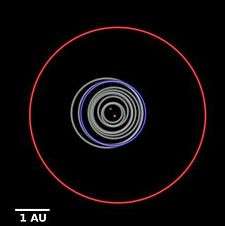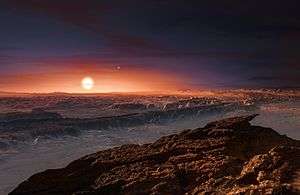Kepler-1647b
| Exoplanet | List of exoplanets | |
|---|---|---|
 | ||
| Parent star | ||
| Star | Kepler-1647 | |
| Constellation | Cygnus | |
| Right ascension | (α) | 19h 52m 36.02s[1] |
| Declination | (δ) | +40° 39′ 22.2″ |
| Apparent magnitude | (mV) | ~13.54 (estimated) |
| Distance | 3700 ly (1134 pc) | |
| Mass | (m) | 1.22[1] M☉ |
| Radius | (r) | 1.79[1] R☉ |
| Temperature | (T) | 6210 K |
| Metallicity | [Fe/H] | -0.14±0.05 |
| Age | 4.4 Gyr | |
| Physical characteristics | ||
| Mass | (m) | 1.52±0.65 MJ |
| Radius | (r) | 1.06±0.0123 RJ |
| Orbital elements | ||
| Semi-major axis | (a) | 2.7205±0.007[1] AU |
| Eccentricity | (e) | 0.0581[1] |
| Orbital period | (P) | 1107.6±0.023[1] d |
| Inclination | (i) | ~90.1[1]° |
| Discovery information | ||
| Discovery date | June 13, 2016 | |
| Discoverer(s) | ||
| Discovery method | Transit | |
| Discovery site | Kepler Space Observatory | |
| Discovery status | ||
| Other designations | ||
| KOI-2939.01; KOI-2939 b; WISE J195236.01+403921.8 b; 2MASS J19523602+4039222 b; KIC 5473556 b; Kepler-1647(AB)-b
| ||
Kepler-1647b (sometimes named Kepler-1647(AB)-b to distinguish it from the secondary component; also known by its Kepler Object of Interest designation KOI-2939.01) is a circumbinary exoplanet that orbits the binary star system Kepler-1647, 3,700 light-years (1,100 pc) from Earth in the constellation Cygnus.[2] It was announced on June 13, 2016 in San Diego at a meeting of the American Astronomical Society.[2] It was detected using the transit method, when it caused the dimming of the primary star, and then again of the secondary star blended with the primary star eclipse.[3] The first transit of the planet was identified in 2012, but at the time the single event was not enough to rule out contamination, or confirm it as a planet.[3] It was discovered by the analysis of the Kepler light-curve, which showed the planet in transit.
Characteristics

Mass and orbit
The exoplanet is a gas giant, similar in size to Jupiter, and has an orbital period of 1107 days.[3] This is the longest transit period of any confirmed transiting Kepler exoplanet discovered yet.[2] It is also the largest circumbinary Kepler planet known.[3] It is 483±206 times more massive than earth, and 1.52±0.65 times Jupiter's mass.[1]
Host stars
The star system, Kepler-1647 (also known as 2MASS J19523602+4039222, KOI-2939 and KIC 5473556), is a binary star with the primary star (Kepler-1647 A) having a mass of 1.22 M☉, a radius of 1.79 R☉, and a surface temperature of 6210 ± 100 K. In comparison, the Sun has a surface temperature of 5778 K.[4] The binary star system's age is estimated to be about 4.4 billion years old, about 200 million years younger than the Sun. The mass, radius, and temperature of the secondary star (Kepler-1647 B), are not known.
The star's apparent magnitude, or how bright it appears from Earth's perspective, is unknown.
Habitability
Kepler-1647b is in the habitable zone of the star system.[2][3] Since the planet is a gas giant, it is unlikely to host life. However, hypothetical large moons could potentially be suitable for life.[2][3] However, large moons aren't usually created during accretion near a gas giant. Such moons would likely have to be captured separately, e.g, a passing protoplanet caught into orbit due to the gravitational field of the giant planet.
See also
References
- 1 2 3 4 5 6 7 8 "Kepler-1647b – NASA Exoplanet Archive". Retrieved June 14, 2016.
- 1 2 3 4 5 "New Planet Is Largest Discovered That Orbits Two Suns". NASA. June 13, 2016. Retrieved June 14, 2016.
- 1 2 3 4 5 6 Kostov, Veselin B.; Orosz, Jerome A.; Welsh, William F.; Doyle, Laurance R.; Fabrycky, Daniel C.; Haghighipour, Nader; Quarles, Billy; Short, Donald R.; Cochran, William D.; Endl, Michael; Ford, Eric B.; Gregorio, Joao; Hinse, Tobias C.; Isaacson, Howard; Jenkins, Jon M.; Jensen, Eric L. N.; Kane, Stephen; Kull, Ilya; Latham, David W.; Lissauer, Jack J.; Marcy, Geoffrey W.; Mazeh, Tsevi; Muller, Tobias W. A.; Pepper, Joshua; Quinn, Samuel N.; Ragozzine, Darin; Shporer, Avi; Steffen, Jason H.; Torres, Guillermo; et al. (2015). "Kepler-1647b: the largest and longest-period Kepler transiting circumbinary planet". arXiv:1512.00189
 [astro-ph.EP].
[astro-ph.EP]. - ↑ Fraser Cain (15 September 2008). "Temperature of the Sun". Universe Today. Retrieved 19 February 2011.
Coordinates: ![]() 19h 42m 36.02s, +40° 32′ 22.2″
19h 42m 36.02s, +40° 32′ 22.2″

.jpg)
